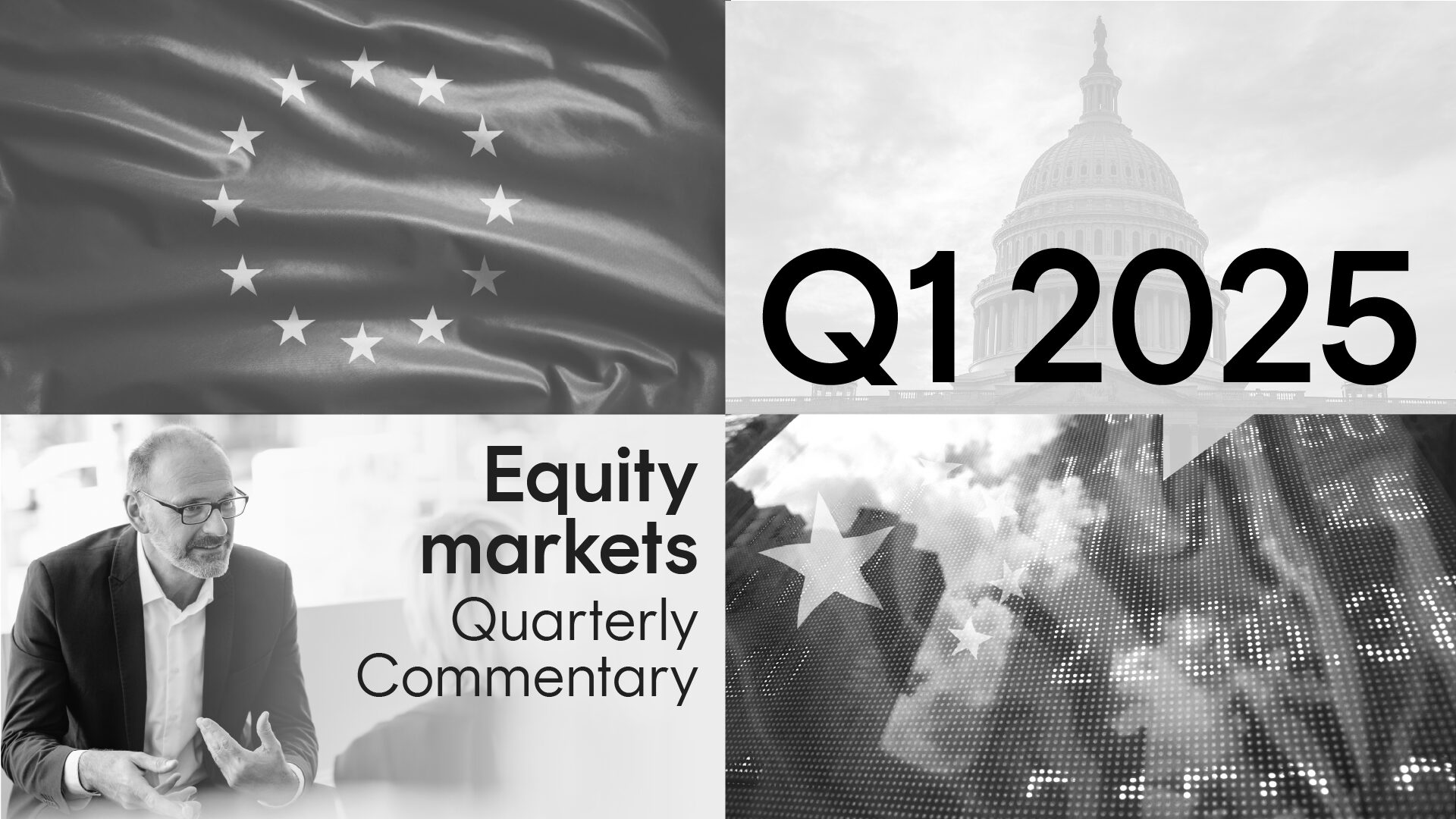Equity Markets Quarterly Commentary Q1 2025
7 minutes reading time
Momentum investing is based on the premise that stocks that have performed well will continue to perform well, and stocks that have performed poorly will continue to perform poorly.
Alongside value and growth, momentum is a ‘rewarded’ style factor backed by academic research which has been shown to persistently generate positive returns over the long-run1. However, unlike these factors, building a portfolio of stocks with strong momentum does not require any fundamental company information or analysis – all that is required is publicly available stock price returns.
This naturally raises the question: If a factor like momentum is so well-known and doesn’t require any special access to data or analysis, then how can returns be sustained over the long run? Wouldn’t this source of outperformance be susceptible to being competed away?
Why does momentum investing work?
The initial research on momentum was published by Jegadeesh and Titman in 19932 and has been found to be persistent since that time3 and pervasive across a range of countries4 and asset classes including equities, currencies, government bonds and commodities5.
These are important criteria that an investment factor needs to meet in order to demonstrate it can be a strong and reliable exposure within an investor’s portfolio. If any of these criteria are not met, then a factor may simply exist due to chance alone.
There are also behavioural and risk-based explanations that can help explain why the momentum factor is persistent and pervasive.
Behavioural
There are various investor biases that may create the conditions for stock price momentum:
- Cognitive biases like herding behaviour says that the buying pressure of investors following the crowd leads to a self-fulfilling prophecy which accelerates the momentum trend and the fear of missing out.
- Another behavioural explanation for the momentum factor is the ‘limited attention bias’ that assumes there is a limit to the amount of information an investor can process in a given period. As a result, you would be more likely to act (buy or sell) when there is a large movement in the share price of a company, as this information is readily available and recallable, than when a stock moves in a small and gradual manner. The end result is that investors with this bias tend to buy into a stock that’s going up while selling those that are going down – fueling momentum.
- And finally, the disposition effect is the tendency of investors to sell stocks whose price goes up (winning stocks) and hold the stocks whose price goes down (losing stocks).Grinblatt and Han (2005)6 argue that investors subject to the disposition effect are eager to make profits – they will sell too early and push the market price below its fundamental value, generating a spread. Over time, the spread will be maintained up until the fundamental value is reached. The convergence of this spread is interpreted as momentum and would also occur in the opposite direction in the face of bad news.
Risk-based
The risk-based explanation holds that momentum investors are being compensated for bearing risk – i.e. the risk of markets suddenly plunging in the event of a recession or major correction. While momentum has positive expected returns over the long run, it can come with large but infrequent losses that risk averse investors may wish to avoid.
For example, momentum experienced a sharp negative reversal throughout the Global Financial Crisis of 2008 but recovered in the years after.
This is an important consideration when it comes to portfolio construction as a single factor exposure can be particularly prone to certain parts of the market cycle. Combining factors such as momentum, value and quality within a portfolio can be an effective way to reduce overall portfolio volatility whilst generating persistent alpha which will be explored in Part 3 of this three-part series on momentum investing.
Momentum Investing around the world and in Australia
The momentum premium has been persistent for more than 20 years since the publication of the aforementioned 1993 paper by Jegadeesh and Titman.
It has also been quite pervasive across different geographies and asset classes. Evidence from a 2012 study “Size, Value, and Momentum in International Stock Returns” by Fama and French examined international stock returns for 23 countries across four regions (North America, Japan, Asia Pacific ex Japan and Europe) where they found that momentum returns were strong everywhere except for in Japan.
Indeed, the MSCI World Momentum Index returned 11.37% p.a. from June 30, 1994 to September 30, 2024 outperforming its parent index (the MSCI World) by 2.9% p.a.
Whilst momentum has been well documented in larger markets like the U.S., the factor works just as well in Australia.
Research by S&P7 showed that compared to the S&P/ASX 200, both an equal weight and float-cap weighted high momentum Australian portfolio had higher absolute returns. Additionally, a portfolio of high momentum stocks in Australia outperformed a portfolio of low momentum stocks on both an absolute and risk-adjusted basis, with similar return volatility and slightly smaller drawdowns over the period from December 2004 to May 2020.
We conducted our own analysis of the momentum effect in Australia. This was done by splitting 200 of the largest listed companies in Australia into quartiles ranked by momentum scores (measured by 12-month risk-adjusted returns).
Each of the four quartile portfolios were rebalanced every 6 months with stock positions equally weighted.
Unsurprisingly, we found that the highest quartile momentum portfolio (the orange line in the chart below) outperformed the lowest quartile momentum portfolio (grey line) by almost 12% p.a. since 2011, as shown in the chart below.
 Source: Bloomberg, Betashares. The analysis covers the period from 31 January 2011 to 29 October 2024. Past performance is not indicative of future returns.
Source: Bloomberg, Betashares. The analysis covers the period from 31 January 2011 to 29 October 2024. Past performance is not indicative of future returns.
Having said that, high momentum stocks (such as the highest quartile portfolio) can be particularly susceptible to sharp reversals such as during early 2020 when the covid pandemic shocked markets. During the worst of the selloff that year (from 20 February to 23 March), the highest momentum stocks (first quartile) sold off around -44% compared to -36% for the benchmark ASX 200.
However, under the risk-based framework for explaining the momentum premium, investors who are willing to bear this risk would have been rewarded with both higher absolute and risk-adjusted returns.
Introducing Betashares Australian Momentum ETF (ASX: MTUM)
Momentum is a well-researched factor backed by empirical evidence that has been proven to generate persistent outperformance above and beyond market beta over the long-run.
Betashares has recently launched MTUM Australian Momentum ETF – the first ETF to provide access to an Australian equities momentum strategy, which is now available on the ASX.
For Part 2 of this three-part series on momentum investing, we will delve further into the Betashares Australian Momentum ETF and explore:
- MTUM’s systematic approach to momentum investing and how it differs to a traditional momentum strategy,
- and the important considerations MTUM includes around liquidity, execution and market impact costs.
Stay connected to our Insights page here for the upcoming Part 2 and 3 articles, as well as in-depth market analysis and thought pieces on investing, portfolio construction and the ETF industry.
There are risks associated with an investment in MTUM, including market risk, index methodology risk, portfolio turnover risk and concentration risk. Investment value can go up and down. An investment in the Fund should only be made after considering your particular circumstances, including your tolerance for risk. For more information on risks and other features of the Fund, please see the Product Disclosure Statement and Target Market Determination, both available on this website.
Sources:
1. Jegadeesh, Narasimhan and Sheridan Titman, “Returns to Buying Winners and Selling Losers: Implications for Stock Market Efficiency Author(s)”, March 1993 ↑
2. Jegadeesh, Narasimhan and Sheridan Titman, “Returns to Buying Winners and Selling Losers: Implications for Stock Market Efficiency Author(s)”, March 1993, pp. 65-91 ↑
3. Swedroe, Larry E. and Andrew L. Berkin, “Your Complete Guide to Factor-Based Investing”, 2016, pp. 78 ↑
4. Fama, Eugene F. and Kenneth R. French, “Size, Value, and Momentum in International Stock Returns,” Journal of Financial Economics, September 2012, 105(3): 457-72 ↑
5. Geczy, Christopher C. and Mikhail Samonov, “215 Years of Global Multi-Asset Momentum: 1800-2014 (Equities, Sectors, Currencies, Bonds, Commodities and Stocks),” May 2015. ↑
6. Grinblatt, Mark and Bing Han, “Prospect theory, mental accounting, and momentum”, Journal of Financial Economics, November 2005 ↑
7. Zeng, Liyu and Priscilla Luk, “How Smart Beta Strategies Work in the Australian Market”, June 2020, pp. 9 ↑




